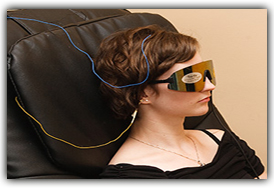
By Richard Soutar, Ph.D.
$595.00
Email: support@newmindacademy.com
For over a decade Dr Soutar has researched and routinely applied photic entrainment in his clinics as well as presented cutting edge workshops on the topic at major neurofeedback conferences. As a leading expert in this field and developer of the first photic EEG database system he is able to provide unique insights on how to synthesize neurofeedback, biofeedback and photic entrainment. Together these technologies can significantly improve clinical outcomes. Combining Photic, Neurofeedback, Heartmath and other modalities allows practitioners a whole new range of options in their efforts to meet the needs of their clients. In addition our workshop will provide you with important information regarding the different equipment available for implementing these technologies and the advantages and limitations they offer.
Arousal Dysregulation, Stress and the Use of Audio/Visual Entrainment, Neurofeedback, Cranio-Electro Stimulation and Transcranial DC Stimulation as Treatment Modalities
EEG Definitions & Dimensions of Analysis
Amplitude, Magnitude & Power Frequency Component Bands Spectral Analysis Dominant Frequency Phase Coherence Asymmetry
Overview
Unlike animals, humans have fear responses to a great number of factors such as over-stimulation, rejection, negative media and loss of "alpha-dog" status. These “social” fears normally result in increased aggression and take a toll on the body, mind and relationships. Arousal disorders arise from genetic, prenatal stress, diet and life stressors. All of these factors strongly influence neurotransmitters, EEG activity and subsequent behavior. A new perspective of the fear response will be presented as well as new QEEG research showing why people in fear with anxiety and depression lack self-awareness and awareness of others, resulting in hampered social ability and greater feeling of social alienation. Nutrition has a huge effect on the brain. Find out about vitamins and how their deficiencies cause anxiety, insomnia, cognitive decline and depression.
Since the discovery of photic driving by Adrian and Matthews in 1934, much has been discovered about the benefits of entraining brainwaves, or audio-visual entrainment (AVE) as it is commonly known today. Research on the effectiveness of AVE in promoting relaxation, hypnotic induction, and meditation will be discussed. The physiological and/or psychological aspects of treatment with AVE in ADD, SAD, PTSD, migraine headaches, chronic pain, anxiety, depression and falling in seniors will be reviewed in detail. Techniques and clinical results, including pre-post brain maps and HRV outcomes will be shown. Treatment protocols (with the DAVID systems) for insomnia, chronic fatigue, fibromyalgia, trauma, anxiety, depression, seasonal affective disorder, ADD, ADHD, and cognitive disorders will be presented, as well as, how to write "prescriptions" into the system.
AVE Assisted Neurofeedback
We have used AVE with neurofeedback in our clinics for over a decade and we have found Ave to be a valuable tool to add to your neurofeedback toolbox. Entrainment can be used to prepare clients for sessions as well as manage them during a training session. Research and clinical experience shows entrainment can significantly enhance neurofeedback training and can improve client performance during sessions to help them uptrain or downtrain target frequencies. Entrainment can also be used between sessions to help clients maintain gains made as a result of training sessions. Once clients have completed their neurofeedback training, entrainment can be used to help them overcome any backsliding that may occur due to excess stress or trauma in their life. Entrainment is an easy to learn technology which can help distinguish your practice and increase the quality of your neurofeedback client’s training experience. In many cases it can be used to assist clients in managing their symptoms if they cannot afford neurofeedback or live too far aware to come in to your office for training. When used consistently, entrainment can contribute to positive and permanent changes in the electrophysiology of the brain.
Cranio Electro-stimulation (CES), another rapidly growing technology, has been shown to reduce anxiety and improve cognitive function in recovering alcoholics and drug addicts. Treatment of generalized anxiety, depression, attention disorders, and insomnia with CES as a tool, will also be discussed.
Transcranial DC Stimulation is the application of an anode (+ve) or cathode (-ve) electrode to enhance or inhibit brain activity under the electrode. Roughly 70 studies of all kinds exist on the topic. These studies will be reviewed as well as information on electrode size, amperage used and current density and electrode placement will be reviewed.
A Brief History of Entrainment
Research Overview
Mechanisms of Entrainment
Standard Entrainment Protocols
NFB Guided Entrainment Concepts
NFB vs Entrainment: Similarities & Differences in Effects On The Brain
Using Entrainment Technologies to Prepare Clients for NFB
Targeting NFB Training Frequencies with Entrainment
Uptraining vs Downtraining with Entrainment
Session Profiles: How to Blend Technologies in a Session
Lunch
Practicum: Using NFB With Entrainment
Targeting Frequencies Using qEEG
Networks & EEG Recruitment Patterns In NFB Guided Entrainment
Training with vs Training against Recruitment Patterns
HeartMath Research & Mechanisms
Breathing Methods
Combining NFB, Heartmath & Entrainment
Multimodal Intervention Approaches
Integrating Traditional Biofeedback Modalities
Multimodal Intervention Approaches
Entrainment as Home Training Support for NFB
Post NFB Support with Entrainment: Sustaining NFB Gains in Stressful Environments
Lunch
Practicum